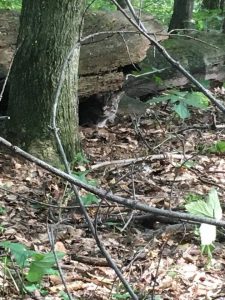Maybe it’s an evolutionary callback to a long-unneeded instinct, but the cover of trees always feels like a form of sanctuary. Though the reek of manure pervades the entrance to the forest, the worn wooden path quickly guides us away from this memory of agriculture and the endless fields of government-subsidized corn we passed. Here, the soft scent of leaf decay and fresh air fills the air below the leaves. The path aside, it’s easy to get lost as if into another world as the tiredness of a day of lectures is shed in the green-lit shade.
The strength and age of the trees surrounding us awed me. Many of the thick trunks were over 400 years old—extant through roughly sixteen human generations and older than the country many of our number call home. The forest, changed though it may be by human intervention, can still resonate with a part of me that came before the development of speech. The sensation is timeless and miraculous, and not one I’ve ever found away from nature.
My eyes are drawn to the sight of decay and growth contentedly commingling across the forest floor. I’ve always found mushrooms amusing and fascinating in turn. Did you know fungi are actually more closely related to eukaryotes, us, than they are to plants? Stranger still, what we see of the fungus is actually no more than its fruiting body. They have long complicated circulatory systems that stretch beneath our feet, often many times larger than we expect and significantly larger than we see. The fungi here seem to be quite happy in their role of breaking down the dead, just as brightly colored as the flowers that sprout beside them, from the fertilizer they leave behind.
This cyclical relationship is continued in the trees, taking a bizarre form in the sight of colonies of beech blight aphids, the white clouds that dotted the branches of the light grey beech trees. These aphids have a cotton protrusion from their body, like a peacock’s decorative plume, and united together these tiny insects resemble another sort of alien fungus. They feed on the beech trees, and in turn, I’m certain, are food for something else. I’m always blown away at how nature can have such structure and flexibility of design, that for all my years of novice but dedicated research and exploration I can still encounter new creatures even in my home state.
And I can also encounter some familiar ones in peculiar places. Walking along taking photos of felled logs, I froze at the familiar sight of a set of eyes and ears. Camouflaged almost perfectly among the leaf litter beneath a log, was a cat! It seemed to be perfectly content beneath its log, eyes-half closed in the comfort of a well-fed predator. We sat, quietly regarding one another, until it was time for us to go. Unlike this remarkable species, we humans are not so flexible in our choice of home, and it was time for us to leave.

I really like how you describe the awe in your surroundings. You do a very good job transporting your reader into Johnson Woods with you. It is also very easy to follow your gaze as you wander through the forest. I found your descriptions of the cyclical in the forest fascinating. You did a great job relating the majesty of the old with the excitement of new growth. My attention was also well captured by your use of factual information and asking questions.
I love your description of the mushrooms, it went into more depth than I did. The theme of interconnectedness and timelessness was really enjoyable as well. Also it was relieving to learn what those little white things are called, because I saw them too and was mystified! This was an informational and insightful read, thank you.